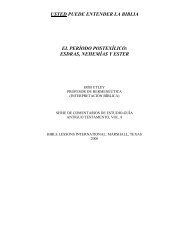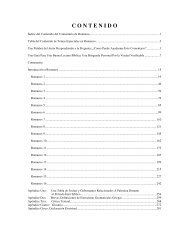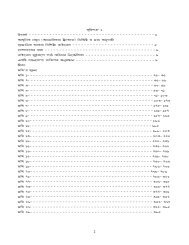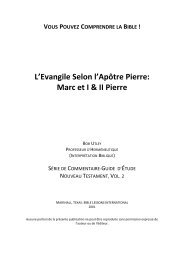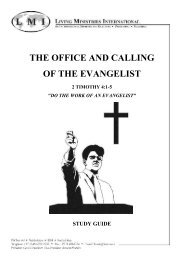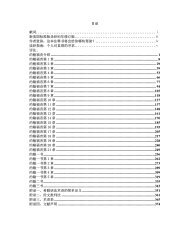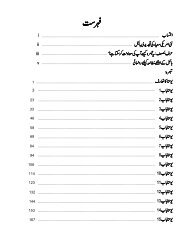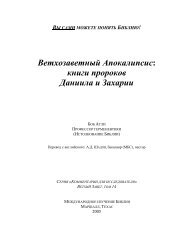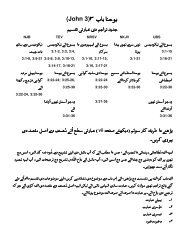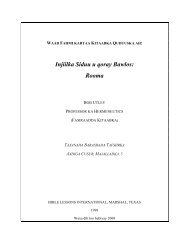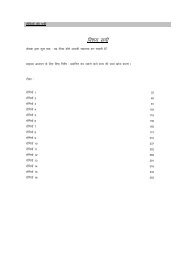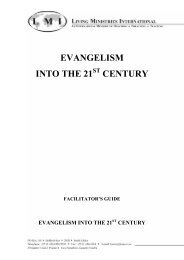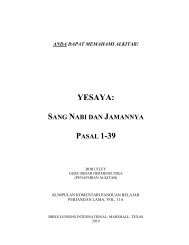- Page 1 and 2: YOU CAN UNDERSTAND THE BIBLEISAIAH:
- Page 3 and 4: Isaiah 26 .........................
- Page 5 and 6: Elder, II John 1 ..................
- Page 7 and 8: The Hebrew text used is Biblia Hebr
- Page 9 and 10: II.Aspects of PredicationA. VERBSTh
- Page 11 and 12: should clearly grasp, not so much t
- Page 13 and 14: c. something which is possible or e
- Page 15 and 16: NIVNJBNRSVOTPGREBRSVNew Internation
- Page 17 and 18: A. The New King James Version (NKJV
- Page 19 and 20: B. I believe the Bible was written
- Page 21 and 22: . contemporary word usagec. genre3.
- Page 23 and 24: In applying the Bible, it is import
- Page 25 and 26: 4. ambiguous textsAlthough the Engl
- Page 27 and 28: 2. by chronology3. by events which
- Page 29: (3) Israel as(a) wife, 50:1(b) serv
- Page 33 and 34: Volume 1 Volume 2chapters 1-5 ruin
- Page 35 and 36: ISAIAH 1PARAGRAPH DIVISIONS OF MODE
- Page 37 and 38: and protection. They are two sides
- Page 39 and 40: 2. This word can designate the God
- Page 41 and 42: } “Uzziah” Tradition says that
- Page 43 and 44: } “do not understand” This VERB
- Page 45 and 46: 2. Jesus is righteousa. Acts 3:14;
- Page 47 and 48: SPECIAL TOPIC: SANCTIFICATIONThe NT
- Page 49 and 50: 4. daughter of Tyre, Ps. 45:125. da
- Page 51 and 52: }NASB “instruction”NKJV “law
- Page 53 and 54: 4. cease to do evil, BDB 292, KB 29
- Page 55 and 56: 1:18-20 “Come now, and let us rea
- Page 57 and 58: Everyone loves a bribeAnd chases af
- Page 59 and 60: 3. Believers in some cultures must
- Page 61 and 62: NASB (UPDATED) TEXT: 1:27-3127Zion
- Page 63 and 64: DISCUSSION QUESTIONSThis is a study
- Page 65 and 66: following the original author’s i
- Page 67 and 68: 2:2 “In the last days” This phr
- Page 69 and 70: 2. In the OT the enemies of God’s
- Page 71 and 72: From Dictionary of Biblical Imagery
- Page 73 and 74: And there is no end to their treasu
- Page 75 and 76: They are to hide from (v. 10b)1. th
- Page 77 and 78: 2:19 “When He arises to make the
- Page 79 and 80: Read the chapter in one sitting. Id
- Page 81 and 82:
3. Wisdom Literature, 22%, divine a
- Page 83 and 84:
SPECIAL TOPIC: GLORYThe biblical co
- Page 85 and 86:
Isaiah “the nations,” “the pe
- Page 87 and 88:
The OT rejects astral worship (cf.
- Page 89 and 90:
elevated prose or poetry and also w
- Page 91 and 92:
curse formulas against Christians i
- Page 93 and 94:
} “filth” This is a strong term
- Page 95 and 96:
5:29(29)5:30 5:30(30)READING CYCLE
- Page 97 and 98:
4. do, v. 5, what God will do to Hi
- Page 99 and 100:
NASB (UPDATED) TEXT: 5:8-128Woe to
- Page 101 and 102:
. “the shekel of the sanctuary”
- Page 103 and 104:
2. mankind’s enabling by God’s
- Page 105 and 106:
5. Paul asserts that believers get
- Page 107 and 108:
3. let the purpose of the Holy One
- Page 109 and 110:
2. Isaiah 14:203. Jeremiah 8:2; 22:
- Page 111 and 112:
ISAIAH 6PARAGRAPH DIVISIONS OF MODE
- Page 113 and 114:
glory." 4 And the foundations of th
- Page 115 and 116:
SPECIAL TOPIC: SERAPHIMA. This is t
- Page 117 and 118:
2. of peoplea. Israel, Hosea 4:6b.
- Page 119 and 120:
B. Acts - Acts 2:32-33, 38-39C. Pau
- Page 121 and 122:
. “grieved” (e.g., Gen. 6:6,7)c
- Page 123 and 124:
ISAIAH 7PARAGRAPH DIVISIONS OF MODE
- Page 125 and 126:
} “Pekah” He was the usurper of
- Page 127 and 128:
This VERB (BDB 131, KB 149, Hiphil
- Page 129 and 130:
evealed in the NT where the Messiah
- Page 131 and 132:
DISCUSSION QUESTIONSThis is a study
- Page 133 and 134:
Read the chapter in one sitting. Id
- Page 135 and 136:
The first named witness, “Uriah t
- Page 137 and 138:
I Cor. 14:34-35 and I Tim. 2:9-15,
- Page 139 and 140:
lands of Lebanon and Canaan. This g
- Page 141 and 142:
In the new day, the day of the spec
- Page 143 and 144:
} “the LORD who is hiding His fac
- Page 145 and 146:
ISAIAH 9PARAGRAPH DIVISIONS OF MODE
- Page 147 and 148:
2The people who walk in darknessWil
- Page 149 and 150:
9:5 The covenant people’s enemies
- Page 151 and 152:
In spite of all this, His anger doe
- Page 153 and 154:
ISAIAH 10PARAGRAPH DIVISIONS OF MOD
- Page 155 and 156:
10:2 Things are so upside down that
- Page 157 and 158:
NASB (UPDATED) TEXT: 10:12-1412So i
- Page 159 and 160:
23For a complete destruction, one t
- Page 161 and 162:
10:28-32 H. C. Leupold, Exposition
- Page 163 and 164:
ISAIAH 11PARAGRAPH DIVISIONS OF MOD
- Page 165 and 166:
The Jewish Study Bible (p. 807) add
- Page 167 and 168:
9They will not hurt or destroy in a
- Page 169 and 170:
And He will strike it into seven st
- Page 171 and 172:
d. mission team, Luke 10:1,17e. for
- Page 173 and 174:
C. It is similar to Exodus 15 (the
- Page 175 and 176:
12:3 The VERB has two metaphors.1.
- Page 177 and 178:
B. YHWH addresses the surrounding n
- Page 179 and 180:
13Therefore I will make the heavens
- Page 181 and 182:
} “the Almighty” This is the He
- Page 183 and 184:
} “Chaldeans” This was the name
- Page 185 and 186:
READING CYCLE THREE (see p. xvi in
- Page 187 and 188:
There is surely progressive revelat
- Page 189 and 190:
11Your pomp and the music of your h
- Page 191 and 192:
14:9 “Sheol” Sheol is personifi
- Page 193 and 194:
The stars were viewed as angels/god
- Page 195 and 196:
14:28 Notice there is an “oracle
- Page 197 and 198:
ISAIAH 15PARAGRAPH DIVISIONS OF MOD
- Page 199 and 200:
Everyone is wailing, dissolved in t
- Page 201 and 202:
15:5-9 The Jewish Study Bible sees
- Page 203 and 204:
WORD AND PHRASE STUDYNASB (UPDATED)
- Page 205 and 206:
SPECIAL TOPIC: LOVINGKINDNESS (HESE
- Page 207 and 208:
16:12 This verse can be understood
- Page 209 and 210:
WORD AND PHRASE STUDYNASB (UPDATED)
- Page 211 and 212:
}NASBNKJVNRSVTEVNJB“fade”“wan
- Page 213 and 214:
C. James G. Frazer1. Adonis, Attis,
- Page 215 and 216:
ISAIAH 18PARAGRAPH DIVISIONS OF MOD
- Page 217 and 218:
5. related VERB (--7, BDB 852), tin
- Page 219 and 220:
18:4 “For thus the LORD has told
- Page 221 and 222:
WORD AND PHRASE STUDYNASB (UPDATED)
- Page 223 and 224:
the issue! See my sermons on “Why
- Page 225 and 226:
Have led Egypt astray.14The LORD ha
- Page 227 and 228:
}NASB, NKJV “the City of Destruct
- Page 229 and 230:
NASB (UPDATED) TEXT: 19:2323In that
- Page 231 and 232:
They were destroyed twice (1) by Sa
- Page 233 and 234:
ISAIAH 21PARAGRAPH DIVISIONS OF MOD
- Page 235 and 236:
8Then the lookout called,"O Lord, I
- Page 237 and 238:
21:6 Notice the prophet is relaying
- Page 239 and 240:
} “the thickets” Isaiah uses
- Page 241 and 242:
WORD AND PHRASE STUDYNASB (UPDATED)
- Page 243 and 244:
4. breaking down of walls, 998, BDB
- Page 245 and 246:
corporate purpose and hope, they so
- Page 247 and 248:
II.III.Faith is both personal encou
- Page 249 and 250:
a.. Jesus is the Holy One of God (J
- Page 251 and 252:
ISAIAH 23PARAGRAPH DIVISIONS OF MOD
- Page 253 and 254:
WORD AND PHRASE STUDYNASB (UPDATED)
- Page 255 and 256:
It is spelled differently in1. Josh
- Page 257 and 258:
18Her gain and her harlot's wages w
- Page 259 and 260:
ISAIAH 24PARAGRAPH DIVISIONS OF MOD
- Page 261 and 262:
(3) The Sibylline Oracles III, IV,
- Page 263 and 264:
} “and scatters its inhabitants
- Page 265 and 266:
For the windows above are opened, a
- Page 267 and 268:
24:18NASB“the report of disaster
- Page 269 and 270:
DISCUSSION QUESTIONSThis is a study
- Page 271 and 272:
. the purpose of the veil in II Cor
- Page 273 and 274:
2. the second (0/!, BDB 53) means
- Page 275 and 276:
} “wine” Notice the different k
- Page 277 and 278:
}NASB, NKJV “the trickery of his
- Page 279 and 280:
CONTEXTUAL INSIGHTSA. It must be re
- Page 281 and 282:
Again, it is uncertain if this is a
- Page 283 and 284:
26:8 “the way” Notice how this
- Page 285 and 286:
14The dead will not live, the depar
- Page 287 and 288:
1. breath, 11:4; 25:4; 27:8; 30:28,
- Page 289 and 290:
ISAIAH 27PARAGRAPH DIVISIONS OF MOD
- Page 291 and 292:
3. sea/river monster, Gen. 1:21; Jo
- Page 293 and 294:
8You contended with them by banishi
- Page 295 and 296:
1. flowing stream, BDB 987 I, cf. P
- Page 297 and 298:
ISAIAH 28PARAGRAPH DIVISIONS OF MOD
- Page 299 and 300:
3The proud crown of the drunkards o
- Page 301 and 302:
28:8 “tables” This term (BDB 10
- Page 303 and 304:
} “O scoffers” This is a CONSTR
- Page 305 and 306:
} “To do His task, His unusual ta
- Page 307 and 308:
ISAIAH 29PARAGRAPH DIVISIONS OF MOD
- Page 309 and 310:
allusion to Jerusalem. The first st
- Page 311 and 312:
NASB (UPDATED) TEXT: 29:9-129Be del
- Page 313 and 314:
Shall the potter be considered as e
- Page 315 and 316:
SPECIAL TOPIC: RANSOM/REDEEMI. OLD
- Page 317 and 318:
}NASB“mind”NKJV, NRSV,LXX, Pesh
- Page 319 and 320:
2. Second paragraph3. Third paragra
- Page 321 and 322:
30:3 There is no hope in Egypt (cf.
- Page 323 and 324:
30:6 Notice the “beasts” (BDB 9
- Page 325 and 326:
d. 42:17, idolse. 47:10, wickedness
- Page 327 and 328:
c. turn to the right or to the left
- Page 329 and 330:
He has made it deep and large,A pyr
- Page 331 and 332:
ISAIAH 31PARAGRAPH DIVISIONS OF MOD
- Page 333 and 334:
The second term is the Covenant nam
- Page 335 and 336:
2. turning to God, I Kgs. 8:33,48;
- Page 337 and 338:
ISAIAH 32PARAGRAPH DIVISIONS OF MOD
- Page 339 and 340:
32:2 This verse describes in “des
- Page 341 and 342:
32:9,10,11NASB, NKJV,NRSV “compla
- Page 343 and 344:
(3) Deut. 32:40(4) Ps. 93:2(5) Isa.
- Page 345 and 346:
2. II Cor. 13:143. I Pet. 1:2The Sp
- Page 347 and 348:
REB “it will be cool on the slope
- Page 349 and 350:
3. Third paragraph4. Etc.CONTEXTUAL
- Page 351 and 352:
Both “destroyed” (BDB 994, KB 1
- Page 353 and 354:
33:7 “brave men” This is possib
- Page 355 and 356:
Nor any of its cords be torn apart.
- Page 357 and 358:
ISAIAH 34PARAGRAPH DIVISIONS OF MOD
- Page 359 and 360:
11But pelican and hedgehog will pos
- Page 361 and 362:
This VERB (BDB 206, KB 234, Hothpae
- Page 363 and 364:
Edersheim characterizes these as (1
- Page 365 and 366:
ISAIAH 35PARAGRAPH DIVISIONS OF MOD
- Page 367 and 368:
35:1 “wilderness” This word ref
- Page 369 and 370:
35:10 “will return” This VERB (
- Page 371 and 372:
C. This section seems to form a nee
- Page 373 and 374:
NASB (UPDATED) TEXT: 36:4-104Then R
- Page 375 and 376:
that Hezekiah’s officials are ask
- Page 377 and 378:
ISAIAH 37PARAGRAPH DIVISIONS OF MOD
- Page 379 and 380:
3. NASB, “a day of rejection” (
- Page 381 and 382:
NASB (UPDATED) TEXT: 37:14-2014Then
- Page 383 and 384:
As grass on the housetops is scorch
- Page 385 and 386:
a. Prays for the Jews(1) Romans 9:1
- Page 387 and 388:
37:28 “your raging against Me”
- Page 389 and 390:
SPECIAL TOPIC: THE ANGEL OF THE LOR
- Page 391 and 392:
2. Neo-Babylon under Nabopolassar (
- Page 393 and 394:
NASB (UPDATED) TEXT: 38:9-149A writ
- Page 395 and 396:
3. eyes look wistfully to the heigh
- Page 397 and 398:
38:21-22 These verses are absent in
- Page 399 and 400:
his dominion that Hezekiah did not
- Page 401 and 402:
APPENDIX ONEINTRODUCTION TO HEBREW
- Page 403 and 404:
IV.GUIDELINE TO INTERPRETING HEBREW
- Page 405 and 406:
4. All three terms are used of the
- Page 407 and 408:
C. Both men and women are called an
- Page 409 and 410:
u. 722- 705 Sargon II:(1) after a t
- Page 411 and 412:
(b)(c)Cyrus II dethroned Astyages.N
- Page 413 and 414:
2. 336-323 Alexander II “the Grea
- Page 415 and 416:
390
- Page 417 and 418:
Rise of Cyrus585 - 550 Astyages was
- Page 419 and 420:
BABYLONRULERSMEDIA626 - 605 Nabopol
- Page 421 and 422:
KINGS OF THE DIVIDED KINGDOMJUDAH
- Page 423 and 424:
JUDAH’S KINGS (CON’T.)ISRAEL’



